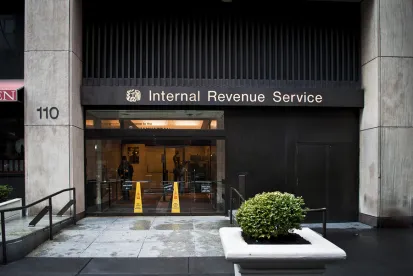On July 31, 2020, the Department of Treasury and IRS issued proposed regulations (the Proposed Regulations) that provide guidance to the “carried interest” rules under Section 1061 of the Internal Revenue Code.
Background of Section 1061
Long-term capital gains derived by individuals are subject to a preferential 20% US federal income tax rate (plus 3.8% “net investment income” tax after certain income thresholds are met). On the other hand, individuals are subject to US federal income tax on short-term capital gains at the graduated ordinary income tax rates with a maximum tax rate of 37% (plus 3.8% “net investment income” tax after certain income thresholds are met).
In typical fund and other joint-venture structures, the fund or other joint venture is structured as a partnership (or an entity treated as a partnership for US federal income tax purposes) and the fund sponsors and other service providers typically structure their incentive compensation in the fund or other joint venture as an interest in the partnership entitling them to a percentage of the partnership’s future income and gains, if any (so-called “carried interest”). This way, if the partnership derives long-term capital gain, such gain that is allocated to the “carried interest” holder will be taxed to him or her as a long-term capital gain rather than as ordinary fee income.
Prior to the enactment of Section 1061, capital gains allocated to a “carried interest” holder would generally be treated long-term capital gains (to the “carried interest” holder) if the gain is derived from a sale or other disposition of a capital asset after a holding period of more than one year. Section 1061, which was added to the Code as part of the 2017 Tax Cuts and Jobs Act, provides that capital gains allocated to a “carried interest” holder will only be treated as long-term capital gains (to the “carried interest” holder) if the gain is derived from a sale or other disposition of a capital asset after a holding period of more than three years.
Carried Interest Definition
Section 1061 refers to a “carried interest” as an “applicable partnership interest.”
An “applicable partnership interest” is defined as a partnership interest held by, or transferred to, a taxpayer, directly or indirectly, in connection with the performance of substantial services by the taxpayer, or by any other related person, in any “applicable trade or business.” In other words, an “applicable partnership interest” is an interest in a partnership’s profits that is transferred or held in connection with the performance of services.
An “applicable trade or business” is any activity conducted on a regular, continuous, and substantial basis which consists of (i) raising or returning capital, and (ii) either investing in specified assets or developing specified assets.
The term “specified assets” means certain securities, certain commodities, real estate held for rental or investment, cash or cash equivalents, options or derivative contracts with respect to any of the foregoing, and an interest in a partnership to the extent of the partnership's proportionate interest in any of the foregoing.
An applicable partnership interest (i.e., a “carried interest”) does not include for purposes of Section 1061 (i) a partnership interest held by a corporation, or (ii) a capital interest in a partnership, i.e., an interest received in exchange for a capital contribution rather than for services.
Effective Date of the Proposed Regulations
Section 1061 itself applies to taxable years beginning after December 31, 2017. The Proposed Regulations generally will become effective only when final regulations are issued but taxpayers may follow the proposed regulations if they apply them in their entirety and in a consistent manner.
The rules in the Proposed Regulations related to S corporations apply to taxable years beginning after Dec. 31, 2017.
Summary of Key Highlights of the Proposed Regulations
-
Gains to Which Section 1061 Applies. The Proposed Regulations provide that Section 1061 generally applies to capital gains and losses allocated to a “carried interest” as determined under Section 1222 of the Code. The Proposed Regulations clarify that Section 1061 does not apply to certain other types of income that are taxed as capital gains under other provisions of the Code, such as:
-
Qualified dividend income, i.e., dividend income from U.S. corporation or certain “qualified foreign corporations” (provided that certain requirements are met),
-
Gains subject to Section 1231 of the Code, i.e., gains from the sale of depreciable property (including real property) used in a trade or business, or
-
Gains under Section 1256 of the Code, i.e., certain gains from derivatives or other financial instruments that are marked to market.
-
Capital gains characterized under the identified mixed straddle rules described in section 1092(b) of the Code.
Capital gains and losses (both one-year and three-year) are netted across all “applicable partnership interests” held by the taxpayer with one result that losses with respect to one interest may offset gains with respect to another.
-
-
S Corporations That Hold a Carried Interest. Section 1061 provides that the three-year holding period requirement does not apply to carried interests held by a corporation. Consistent with prior guidance by the IRS, the Proposed Regulations provide that S corporations are not considered “corporations” for purposes of Section 1061. Accordingly, gain allocated to a “carried interest” held by an S corporation is subject to the three-year holding period requirement.
-
PFICs That Hold a Carried Interest. Section 1061 provides that the three-year holding period requirement does not apply to carried interests held by a corporation. While PFICs are considered “corporations” for purposes of Section 1061, the Proposed Regulations provide that PFICs with respect to which the U.S. shareholder made a Qualified Electing Fund election under section 1295 of the Code (QEF election) are not considered “corporations” for purposes of Section 1061. Accordingly, gain allocated to a “carried interest” held by a PFIC with respect to which the U.S. shareholder made a QEF election is subject to the three-year holding period requirement.
-
Tiered Structures. Under the Proposed Regulations, generally, if an interest in a partnership is issued (or transferred) to a passthrough entity (such as another partnership or an S corporation) in connection with the performance of its own services, the services of its owners, or the services of persons related to either the passthrough entity or its owners, the interest is an “applicable partnership interest” as to the passthrough entity that received the interest even if such entity is not by itself subject to U.S. federal income tax.
Each such passthrough entity in a tiered structure, as well as the ultimate taxpayer, is treated as holding an “applicable partnership interest” for purposes of Section 1061 and the tainted Section 1061 capital gain retains its character as such as it is allocated through tiered passthrough entities.
A carried interest in one entity (for example a fund) issued to a person employed by and performing services for another entity not conducting an “applicable trade of business” (for example a portfolio company) is not treated as an “applicable partnership interest.”
-
Once an “applicable partnership interest,” Always an “applicable partnership interest.” The Proposed Regulations provide that once a partnership interest is an “applicable partnership interest,” it remains an “applicable partnership interest” and never loses that character (e.g., even if the holder no longer provides services to the partnership or the partnership is no longer engaged in an “applicable trade or business”), unless one of the exceptions to the definition of an “applicable partnership interest” applies (e.g., after the “applicable partnership interest” is transferred to a corporation as defined for Section 1061 purposes).
The Proposed Regulations add another exception to this rule for an “applicable partnership interest” acquired for fair market value by a bona fide unrelated purchaser who does not provide (and has never provided) services to the partnership that issued the “applicable partnership interest” provided that certain other conditions are met. In determining whether a particular profits interest is an “applicable partnership interest” activities of the holder and related persons are aggregated across all entities.
-
Relevant Holding Period for Gain Allocable to a Carried Interest. While Section 1061 applies to characterize “carried interest” gain with a holding period of three years or less as short-term capital gain at the taxpayer’s level, the Proposed Regulations provide that the Section 1061 three-year holding period is measured with respect to the specific property that is sold and the holding period of the person (including a partnership) that sold the property.
For example, if a partnership sells property and allocates the gain to the “carried interest” holder, the partnership’s holding period in the disposed property is the relevant measure. Therefore, if the partnership has held the property for more than three years, the gain will be long-term capital gain to the “carried interest” holder, regardless of how long the “carried interest” holder has held the “carried interest.”
-
Relevant Holding Period for Sale of a Carried Interest. The Section 1061 three-year holding period rule also applies to gain derived by a partner from the sale of the partner’s “carried interest” in a partnership. If a partner sells its “carried interest” in a partnership, the gain will generally be long-term capital gain only if the partner has held the “carried interest” for more than three years, regardless of how long the partnership has held its assets.
Nevertheless, under a limited look-through rule provided for by the Proposed Regulations, even if the partner has held the “carried interest” for more than three years before selling it, all or a portion (based on specified rules) of the partner’s gain from the sale of its carried interest will still be treated as short-term capital gain under Section 1061 if 80% or more of the fair market value of the partnership’s assets have been held by the partnership itself for three years or less.
-
Nonrecognition Transfers of Carried Interests. Section 1061(d) requires the recognition of short-term capital gain on a direct or indirect transfer of a “carried interest” to a related person that would not otherwise be a taxable event if the partnership owns assets with built-in gain that it held for less than 3 years. The Proposed Regulations clarify that this rule applies, but is not limited to, contributions, distributions, sales and exchanges, and gifts of a “carried interest” to a related person but not including contributions of a “carried interest” to another partnership.
-
Exclusion of Gain Allocable to Capital Interests. When a “carried interest” holder also holds a capital interest in the partnership, the Section 1061 three-year holding period requirement does not apply to capital gain that is allocated to the capital interest. However, the test for determining when (and what) gain can be treated as allocable to a capital interest (as opposed to the “carried interest”) may be considered narrow under the Proposed Regulations.
Under the Proposed Regulations, an allocation of gain will only be considered to be made to the capital interest (and thus excluded from Section 1061) if the allocation is based on the relative capital accounts of the partners and the terms, priority, type and level of risk, rate of return, and rights to cash or property distributions during the partnership’s operations and on liquidation are the same.
The allocation structure used by many funds may not meet this standard because many typical fund structures allocate income based on the fund’s cash waterfall, which typically has several tiers, and is not simply based on the partner’s relative capital account balances. For example, if partners participate in portfolio investments in different percentages, the capital interest allocation requirement may not be satisfied.
The consequence of not satisfying the allocation requirement is that all applicable capital gain allocated to a “carried interest” holder (even the amount that is purportedly allocated with respect to the holder’s capital interest) will be subject to the Section 1061 three-year holding period requirement.
The final regulations may provide additional guidance with respect to many common fund allocation structures and clarify whether such structures can be used without running afoul of the capital interest allocation requirements.
-
Carried Interest Waiver. Some funds utilize a carried interest waiver provision whereby the carried interest holder waives its right to receive capital gain from assets that have been held for less than three years in return for future allocations of capital gain from assets that have been held for more than three years. The Proposed Regulations do not directly address carried interest waivers, but the preamble to the proposed regulations provides that such waivers may not be respected and may be challenged under the principles set forth in the Treasury regulations governing management fee waiver, and/or the substance over form or economic substance doctrines.
The Treasury regulations governing management fee waiver provide a number of factors that the IRS will consider in determining whether a management fee waiver will be respected. These factors include, among others, that the manager is subject to entrepreneurial risk, that the waiver occurs before the management fee is earned, and that the waiver is irrevocable. The IRS has indicated that it will look to similar factors when determining whether a carried interest waiver will be respected.
-
In Kind Distributions with Respect to a Partner’s Carried Interest. If a partnership distributes property with respect to a partner’s “carried interest,” any gain from a subsequent sale of the property will be treated as long-term capital gain only if the partner’s holding period in the property is longer than three years.
For purposes of this determination, the partner may add the partnership’s holding period to its own holding period. For example, if a partnership holds a capital asset for 2 years and 9 months and distributes the asset to a “carried interest” holder and the “carried interest” holder holds the asset for six months prior to disposition, the partner’s holding period in the asset will be over three years and the gain will be long-term capital gain to the carried interest holder.
-
Capital Gain Dividends from REITs and RICs. If a partnership receives a capital gain dividend from a REIT or RIC, the “carried interest” holder’s share of such capital gain dividend will only be long-term capital gain to the extent the REIT or RIC held the underlying property for more than three years.
For example, if a partner has held a “carried interest” in a partnership for more than three years and the partnership has held an interest in a REIT for more than three years and the REIT makes a capital gain dividend to the partnership that is allocated to the “carried interest” holder, the capital gain dividend will only be long-term capital gain to the “carried interest” holder if the REIT informs the partnership that it held the underlying capital asset that gave rise to the capital gain dividend for longer than three years.






 />i
/>i
